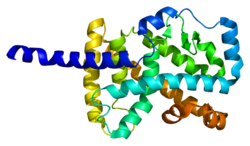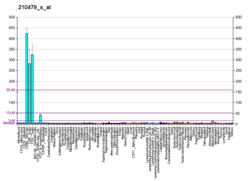RAR-related orphan receptor alpha (RORα), also known as NR1F1 (nuclear receptor subfamily 1, group F, member 1) is a nuclear receptor that in humans is encoded by the RORA gene.[5] RORα participates in the transcriptional regulation of some genes involved in circadian rhythm.[6] In mice, RORα is essential for development of cerebellum[7][8] through direct regulation of genes expressed in Purkinje cells.[9] It also plays an essential role in the development of type 2 innate lymphoid cells (ILC2) and mutant animals are ILC2 deficient.[10][11] In addition, although present in normal numbers, the ILC3 and Th17 cells from RORα deficient mice are defective for cytokine production.[12]
- ^ a b c GRCh38: Ensembl release 89: ENSG00000069667 – Ensembl, May 2017
- ^ a b c GRCm38: Ensembl release 89: ENSMUSG00000032238 – Ensembl, May 2017
- ^ "Human PubMed Reference:". National Center for Biotechnology Information, U.S. National Library of Medicine.
- ^ "Mouse PubMed Reference:". National Center for Biotechnology Information, U.S. National Library of Medicine.
- ^ Giguère V, Tini M, Flock G, Ong E, Evans RM, Otulakowski G (March 1994). "Isoform-specific amino-terminal domains dictate DNA-binding properties of ROR alpha, a novel family of orphan hormone nuclear receptors". Genes & Development. 8 (5): 538–53. doi:10.1101/gad.8.5.538. PMID 7926749.
- ^ Cite error: The named reference
entrezwas invoked but never defined (see the help page). - ^ Sidman RL, Lane PW, Dickie MM (August 1962). "Staggerer, a new mutation in the mouse affecting the cerebellum". Science. 137 (3530): 610–2. Bibcode:1962Sci...137..610S. doi:10.1126/science.137.3530.610. PMID 13912552. S2CID 30733570.
- ^ Hamilton BA, Frankel WN, Kerrebrock AW, Hawkins TL, FitzHugh W, Kusumi K, et al. (February 1996). "Disruption of the nuclear hormone receptor RORalpha in staggerer mice". Nature. 379 (6567): 736–9. Bibcode:1996Natur.379..736H. doi:10.1038/379736a0. PMID 8602221. S2CID 4318427.
- ^ Gold DA, Baek SH, Schork NJ, Rose DW, Larsen DD, Sachs BD, et al. (December 2003). "RORalpha coordinates reciprocal signaling in cerebellar development through sonic hedgehog and calcium-dependent pathways". Neuron. 40 (6): 1119–31. doi:10.1016/s0896-6273(03)00769-4. PMC 2717708. PMID 14687547.
- ^ Halim TY, MacLaren A, Romanish MT, Gold MJ, McNagny KM, Takei F (September 2012). "Retinoic-acid-receptor-related orphan nuclear receptor alpha is required for natural helper cell development and allergic inflammation". Immunity. 37 (3): 463–74. doi:10.1016/j.immuni.2012.06.012. PMID 22981535.
- ^ Gold MJ, Antignano F, Halim TY, Hirota JA, Blanchet MR, Zaph C, et al. (April 2014). "Group 2 innate lymphoid cells facilitate sensitization to local, but not systemic, TH2-inducing allergen exposures". The Journal of Allergy and Clinical Immunology. 133 (4): 1142–8. doi:10.1016/j.jaci.2014.02.033. PMID 24679471.
- ^ Lo BC, Gold MJ, Hughes MR, Antignano F, Valdez Y, Zaph C, et al. (September 2016). "The orphan nuclear receptor ROR alpha and group 3 innate lymphoid cells drive fibrosis in a mouse model of Crohn's disease". Science Immunology. 1 (3): eaaf8864. doi:10.1126/sciimmunol.aaf8864. PMC 5489332. PMID 28670633.






